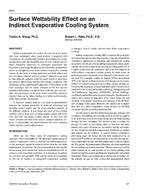Description
Indirect evaporative air coolers that use air-to-air plate-type heat exchangers show good promise (compared with compression air-conditioning systems) of extending the energy savings from arid, low-humidity areas to more widespread climatic conditions. However, no systematic experiment had been done concerning the effect of the wettability of aluminium plates on the effectiveness of the indirect evaporative cooling systems. A testing apparatus was built where only one secondary channel and two primary channels were used so that different surfaces could be easily tested to determine the system’s effectiveness and the heat transfer coefficient. The advantage of this experimental apparatus is that plates of the heat exchanger can be easily changed in the test section instead of fabricating a complete heat exchanger for each test. Also, the experiment can be more closely controlled and more detailed data can be taken, leading to a better understanding of the heat transfer mechanism. A dynamic contact analyser was used to quantitatively measure the wetting properties in terms of advancing and receding contact angles and the water-retention capacity of the different surfaces. It was found that most of the wicking surfaces had at least zero receding contact angles and some even had zero advancing contact angles. In this case, the water retention test had to be used to compare different surfaces. A relationship was found between the water retention ability and the system’s effectiveness.
KEYWORDS: year 1996, indirect cooling, surfaces, wet, evaporative cooling, evaporative coolers, aluminium, air air heat exchangers, energy conservation, performance, testing, heat transfer coefficient, experiment, heat exchangers
Citation: ASHRAE Trans. 1996, vol.102, part 1, paper number 3975, 427-433, 11 figs., 2 tabs., 3 refs. bibl.
Product Details
- Published:
- 1996
- File Size:
- 1 file , 870 KB
- Product Code(s):
- D-16551




